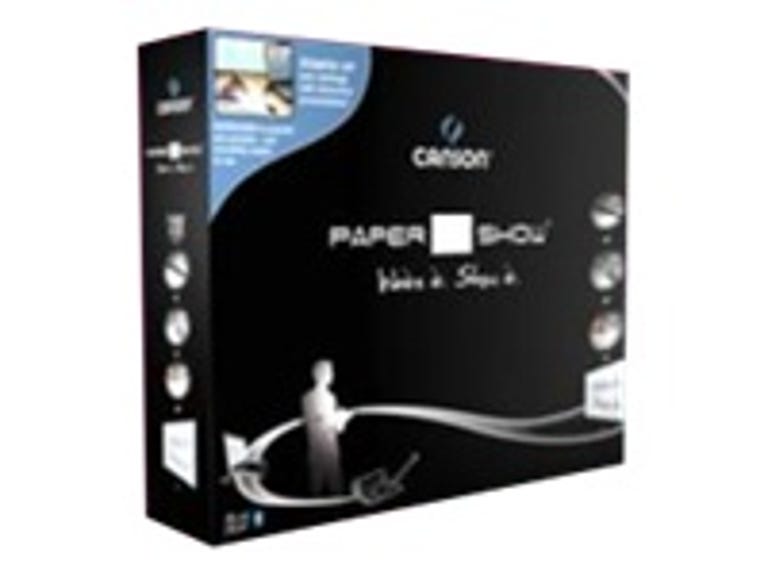 Why You Can Trust CNET
Why You Can Trust CNET Canson PaperShow Kit review: Canson PaperShow Kit
Canson PaperShow Kit
When it comes to the traditional computer interface, so far nothing has been able to replace the keyboard and mouse. Once in a while, however, an alternative interface device comes along that makes specific tasks much easier. Canson's $199 PaperShow kit is one such device. Nonetheless, make sure you are comfortable with setting up Bluetooth devices and are aware of the ongoing costs for special paper before purchasing.
The Good
The Bad
The Bottom Line
The kit includes a battery-operated Bluetooth pen, a USB Bluetooth key, and special PaperShow papers. The pen and the paper themselves work just like any normal pen and paper, however, once the pen is connected to the USB Bluetooth key, everything you write on the paper will also appear as a digital version on the computer screen.
You can also erase what you just wrote--as you would using drawing tool software like Paint--or save the digital version as a PowerPoint file. Additionally, you can open an existing PowerPoint presentation and use the pen and paper to edit it.
The process of setting up the device was simple. Just plug the USB Bluetooth key into the computer's USB port and its self-contained software should automatically launch to set up both software and drivers. The key then looks for the Bluetooth pen, and the two will pair themselves together.
Unfortunately, we did run into a few hiccups during this setup process on our Windows XP SP3-based testbed. The key and the pen didn't pair successfully at first. As it turned out, we needed to disable any existing Bluetooth adapter connected to the computer and make sure that the Bluetooth service is run by the local Windows account. The folks at Canson, however, told us that only computers with certain specifications would run into this problem. Nonetheless, we wish the setup had gone smoother. Once we got through the hiccups and set up the device, the kit worked as expected.
Each sheet of the PaperShow paper has an area where you can tap the pen to change the colors, shape, and boldness of what will appear on the screen. The kit contains one A4-size notebook--supposedly for brainstorming sessions--and 30 sheets of separate paper for presentations.
The paper works like normal paper, but also features Anoto technology and contains microscopic black dots. Though each individual dot is nearly invisible to the human eye, each paper sheet contains thousands of them and looks like you have just sprayed a very thin layer of pepper on it. These dots allows the pent to read the coordinates of where it is on the paper and transmit the information via Bluetooth to the USB adapter.
It's important to note that what you write on the paper will stay there, even if you erase it on the digital version. This means, down the line, you will need to buy more paper to use. According to Canson, a stack of 200 sheets of PaperShow presentation paper (separate sheets) costs $19.98. If you want to get the pad for brainstorming (which is not suitable for use with a printer), they cost $19.98 for the A3 size and $12.98 for the A4 size. Each pad contains about 200 sheets. This price is about four times that of regular copy paper, which costs about $6 per 500 sheets.
In our test we were able to use the pen up to 20 feet away from the Bluetooth adapter, even if we were not in its line of sight. This is promising for real-world situations where you may want to walk around, away from the Bluetooth adapter, while giving a presentation.
On the downside, the pen saps battery power really fast. In our trial, we got a low battery warning after just about an hour and half of using it. We found that putting the cap on the pen while not in use, which essentially turns of the Bluetooth, helps conserve some battery power. Once we took the cap back off, it took just a few seconds for the pen to get paired again to the key.
The PaperShow software takes about 20 seconds to open (or import) an existing PowerPoint presentation of about 10 slides. Once it was open, the software would recommend that you print the slides onto PaperShow paper in order to edit the imported version. The advantage of doing so is that you then have the option to add real-time sketches or drawing to the presentation slides.
Most people won't have a use for the PaperShow, but if you do presentations on a regular basis or need to exchange ideas in a large brainstorming group, the PaperShow makes for a useful and creative way to do so.


